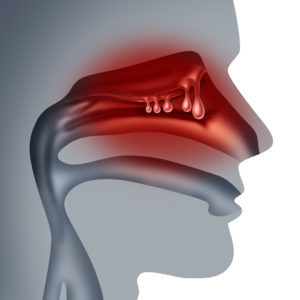
Endoscopy is a medical term for a procedure to look inside the natural body openings (ears, mouth, nose etc.). As you can see for yourself, it is pretty dark there. So, doctors use flexible cords that have a bright light and a tiny camera at the end – it is called rhinoscope here because it is used to look in the nose and throat.
Endoscope is a fantastic medical instrument allowing doctors trained in this procedure to instantly make a diagnosis and offer you the best treatment.
Nasal endoscopy is also useful for looking at the vocal cords, when the cord is lowered in the low portions of the throat. As you can easily talk and swallow during this procedure, laryngoscopy is useful for diagnosis or cough and hoarseness caused by abnormal vocal cords.

If you have congestion or sinus infection, a doctor may want to use a medical technology to find out what is going on. If you think you nose is the part you can see in the mirror – you are wrong! There are so many hidden parts, which doctor will need to see to figure out what is wrong.
Nasal anatomy is very complicated. It includes 5 large cavities hidden in the facial bones (sinuses) and nasal folds (turbinates). Two of the nasal passages start at the nostril and end at the back of the throat where adenoid tissue is. The nose is divided by septum which has frontal part made of cartilage and back part made of bone.
Nasal endoscopy, or rhinoscopy, is used to look at deeper upper airway structures:
A small portion of the inner nose can be seen by a regular otoscope. But if you have congestion, or worries about sinus infection, a doctor may use a fast and easy way to look at the problematic area with a scope.

Laryngoscopy is an extended procedure after rhinoscopy. Doctors use these names interchangeably, as most of the time both procedures are performed at the same time. Laryngoscopy is used to look at the throat structures:
Doctor may use laryngoscopy if you have chronic cough and hoarse voice. It is also used to diagnose VCD – vocal cord dysfunction.

Imaging studies, such as x-Ray and CT, are traditionally used to see if there is an anatomical problem with the face bones, or a hidden infection in one of the sinuses. Endoscopy can be used as a fast and reliable diagnostic procedure.
If a doctor discovered a problem during rhinoscopy, you may be referred to the imaging center for the appropriate procedure. Or, you may get a referral to a surgeon ENT for a consultation. But the great thing about it, you may be able to avoid the imaging and other visits all together, if the doctor can clearly see the diagnosis!
With respect to patients with chronic rhinosinusitis without polyps, nasal endoscopy could be utilized as a beneficial objective tool.
Doctors can use nasal scope to diagnose or confirm many different upper respiratory diseases and conditions:

While this procedure is considered “minor surgical”, it is done in the office and requires very little time for preparation. It will not hurt if your nose is well-anesthetized and decongested.
That is why we use the nasal spray that contains a mixture of Lidocaine (same local pain-killer that dentists use) and Afrin (topical decongestant). It takes 3-4 sprays each nostril and about 10 min until your nose is numb and nasal passages clear.
Another great trick is a surgical gel that doctor will use to coat a part of endoscope which will slide inside your nose. Now, when the tip of endoscope will move, you will only feel it’s presence, but no pain.
Sometimes, especially if your nose is allergic or inflamed, the mucus membrane becomes extremely fragile, and may bleed if the tip of the scope is touching it. Also, as the pain medicine leaks down the throat, you may feel bitter taste.
It is not recommended to eat or swallow if your throat is still numb – you may choke or gag. We always ask you to sit extra 10-15 min until anesthesia is wearing off completely.
There are no significant risks of this procedure, as doctors use flexible scope. You may read about nasal perforations and injuries, but that applies only to rigid scopes that are not used by our office.
While many ENT doctors use the endoscopy for surgeries and biopsies, Allergy-Immunology doctors use rhinoscope for diagnosis and screening only. If the doctor will find a suspicious growth or an anatomical defect, you will be referred to the best ENT surgeons for a consultation.

Nasal endoscopy is a very safe procedure, because our doctors use single-use disposable sheaths. It comes in a sealed package, and will be covering all lengths of the scope that will be in contact with doctor’s hand and your nose.
While you will be asked to remove the mask, we take extreme precautions against all infections. We are all fully-vaccinated, testing on regular basis, and not allowing our staff to work if symptomatic.
As our patients are mostly immunocompromised, we are fully equipped with anti-infection procedures and policies since we opened in 2010. We are proud of “0” COVID infections in our office since epidemic started.
Schedule an appointment to ask any questions you have! We encourage all our patients to ask everything before the procedure! There are no dumb questions. Our doctors will explain every step and reassure you if you have any fears or concerns. Even more, if you are still uncomfortable to have a nasal scope, doctor will discuss all alternatives with you. Do not worry – we will always do only what is best for you.
References:
Nasal Endoscopy Versus Other Diagnostic Tools in Sinonasal Diseases. K Maru Y, Gupta Y.Indian J Otolaryngol Head Neck Surg. 2016 Jun;68(2):202-6. doi: 10.1007/s12070-014-0762-y. Epub 2014 Aug 12.PMID: 27340637 Free PMC article.
Recent advances in allergic rhinitis. Hoyte FCL, Nelson HS.F1000Res. 2018 Aug 23;7:F1000 Faculty Rev-1333. doi: 10.12688/f1000research.15367.1. eCollection 2018.PMID: 30210782 Free PMC article. Review.
The Role of Allergic Rhinitis in Chronic Rhinosinusitis. Helman SN, Barrow E, Edwards T, DelGaudio JM, Levy JM, Wise SK.Immunol Allergy Clin North Am. 2020 May;40(2):201-214. doi: 10.1016/j.iac.2019.12.010. Epub 2020 Jan 14.PMID: 32278445 Free PMC article. Review.
Relationships among allergic rhinitis, asthma, and chronic rhinosinusitis. Rosati MG, Peters AT.Am J Rhinol Allergy. 2016 Jan-Feb;30(1):44-7. doi: 10.2500/ajra.2016.30.4252.PMID: 26867529 Free PMC article. Review.
A Retrospective Study of Establishment of Association Between Deviated Nasal Septum, Sinusitis and Chronic Dacryocystitis. Anand Chavadaki J, Raghu K, Patel VI.Indian J Otolaryngol Head Neck Surg. 2020 Mar;72(1):70-73. doi: 10.1007/s12070-019-01745-4. Epub 2019 Nov 2.PMID: 32158659 Free PMC article.
Is Computed Tomography Imaging of Deviated Nasal Septum Justified for Obstruction Confirmation? Janovic N, Janovic A, Milicic B, Djuric M.Ear Nose Throat J. 2021 Feb;100(2):NP131-NP136. doi: 10.1177/0145561319871533. Epub 2019 Sep 19.PMID: 31533464 Free article.
Is Nasal Endoscopy of Diagnostic Value in Chronic Rhinosinusitis Without Nasal Polyps? Cohen-Kerem R, Marshak T, Uri N, Gruber M, Huberfeld O, Paz D, Stein N, Ronen O.Ear Nose Throat J. 2021 Mar;100(3):172-176. doi: 10.1177/0145561319864578. Epub 2019 Sep 23.PMID: 31547708